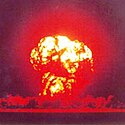Wikipedia:Today's featured list/September 2012
|
Featured list tools: |
September 3
The Hugo Award for Best Fan Artist is given each year for artists of works related to science fiction or fantasy which appeared in low- or non-paying publications such as semiprozines or fanzines. A Hugo Award for professional artists is also given. Hugo Award nominees and winners are chosen by supporting or attending members of the annual World Science Fiction Convention, or Worldcon, and the presentation evening constitutes its central event. The selection process is defined in the World Science Fiction Society Constitution as instant-runoff voting with five nominees, except in the case of a tie. Worldcons are generally held near Labor Day and in a different city around the world each year. Brad W. Foster (pictured) has received the most awards, with eight wins from twenty-four nominations. William Rotsler and Tim Kirk have won five awards, from twenty-three and eight nominations respectively. The only other artists to win more than twice are Teddy Harvia, with four out of twenty nominations, Alexis A. Gilliland, with four out of eight, and Frank Wu, also with four out of eight. (Full list...)
September 10
The lifetime of British writer, philosopher, and feminist Mary Wollstonecraft (illustration pictured) encompassed most of the second half of the eighteenth century. Her educational works, such as her children's book Original Stories from Real Life, helped inculcate middle-class values, and her two Vindications, A Vindication of the Rights of Men and A Vindication of the Rights of Woman, argue for the value of an educated, rational populace, specifically one that includes women. In her two novels, Mary: A Fiction and Maria: or, The Wrongs of Woman, she explores the ramifications of sensibility for women. After two affairs with the artist Henry Fuseli and the American adventurer Gilbert Imlay (with whom she had an illegitimate daughter, Fanny Imlay), Wollstonecraft married the philosopher William Godwin, one of the forefathers of the anarchist movement. Together, they had one daughter: Mary Shelley, the author of Frankenstein. (Full list...)
September 17
There are 11 seasons and 251 episodes of M*A*S*H, an American television series that covered a three-year military conflict. The series was developed by Larry Gelbart and adapted from the 1970 feature film MASH, which was itself based on the 1968 novel MASH: A Novel About Three Army Doctors by Richard Hooker. The television episodes were produced by 20th Century Fox Television for the CBS network and aired from September 17, 1972, to February 28, 1983. Out of the series' 251 episodes, 245 are half an hour long, 5 are an hour long, and the finale, "Goodbye, Farewell and Amen," is 2½ hours long. 24 episodes aired on a Sunday, 23 aired on a Saturday, "Dr. Pierce and Mr. Hyde" aired on a Thursday, 66 aired on a Tuesday, 22 aired on a Friday, 114 aired on a Monday and "Rally Round the Flagg, Boys" aired on a Wednesday. "Goodbye, Farewell and Amen" became the most-watched television show in American television history with 106 million viewers. The series continues to air in syndication, while the entire run has been released on DVD. (Full list...)
September 24
The parties to the Comprehensive Nuclear-Test-Ban Treaty (CTBT) are the states that have signed and ratified the international agreement banning all nuclear explosions in all environments. If the treaty enters into force, these states will also be member states of the Comprehensive Nuclear-Test-Ban Treaty Organization (CTBTO). States Signatories are Members of the CTBTO Preparatory Commission. On September 24, 1996, the CTBT was opened for signature. All five nuclear weapons states recognized under the Nuclear Non-Proliferation Treaty signed the treaty, with 66 other states following that day. Fiji became the first state to ratify the treaty on October 10, 1996. The treaty will come into force with the signature and ratification of all countries which participated in the 1996 Conference on Disarmament and possessed nuclear power or research reactors at that time, known in the treaty as Annex 2 states. Eight such states have not ratified the treaty: China, Egypt, Iran, India, Israel, North Korea, Pakistan and the United States. (Full list...)




